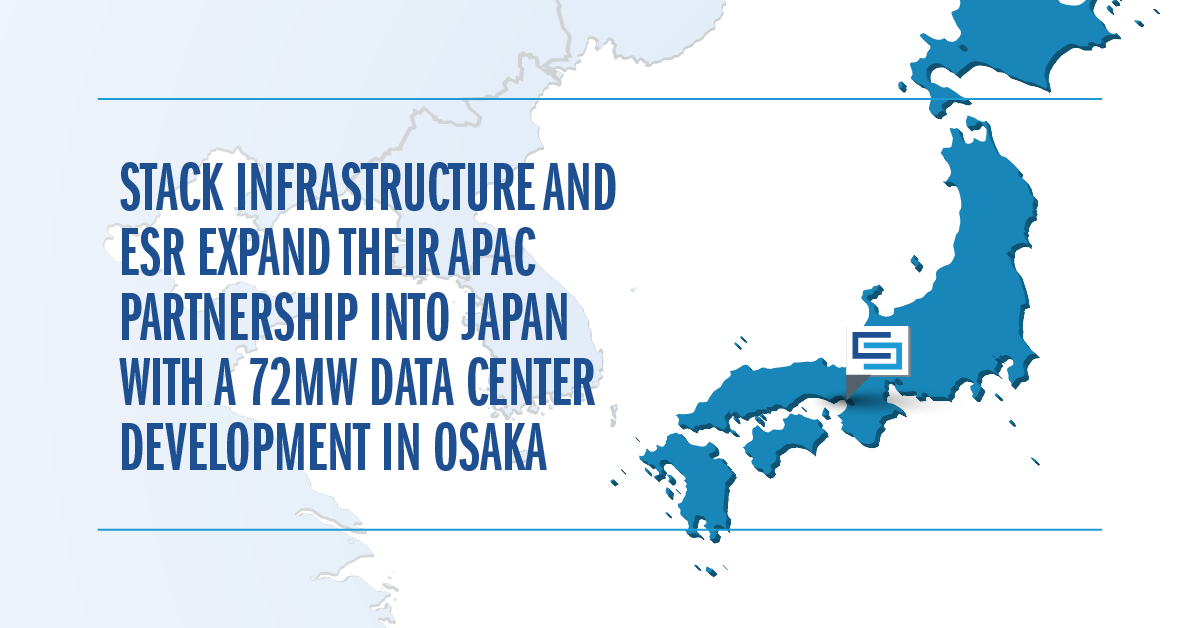Hyperscale Data Centres: Scale, Speed & Strategy
Data Centres
Hyperscale Data Centres: Scale, Speed & Strategy
News
Stream Data Centers' newly appointed VP of Finance
Stream Data Centers has announced the newest addition to its executive leadership team: Callan Space as Vice President of Finance. In this role, Callan will spearhead the development of new financial processes, goal-supported structures and investor partner collaborations that will help the company continue to effectively scale its growth while meeting evolving data centre customer needs. The addition of Callan represents another strategic leadership addition to support the company’s accelerated growth trajectory.
As a seasoned executive in the critical infrastructure industry, Callan brings crucial insight from her career building exceptionally successful teams and processes for one of the world’s largest hyperscalers. Before joining Stream, she served as the Senior Finance Manager for Amazon, where she was instrumental in leading the US East data centre region. Her deep subject-matter expertise and experience driving efficiencies at scale made her the ideal candidate to support the company’s accelerated expansion.
“I am extremely excited to join Stream and help build a world-class finance organisation to continue supporting the industry’s largest and most advanced hyperscale and global enterprise customers,” comments Callan. “I’m looking forward to bringing insights and the strong business partnership experience I garnered across nearly a decade of procurement and financial process leadership for a world-renowned hyperscaler during its full-scale maturing process. Furthermore, as someone who grew up on a dairy farm in upstate New York and is accustomed to working in a 24/7 environment where everyone works hard and shows up for customers (even if they are cows), I bring an unusually colourful skillset to work.”
“Stream has been growing strategically at a rapid rate to support complex and evolving customer requirements, and we believe that Callan is the right person for ensuring that our financial goals and strategies align with this commitment,” states Paul Moser, Stream’s Co-Managing Partner. “Stream leadership is excited to welcome her to our team, and we look forward to seeing her in action as we ensure customer success well into the future.”
Beatrice - 21 December 2022
Hyperscale Data Centres: Scale, Speed & Strategy
News
Arista delivers next generation switching for compute and storage
Arista Networks has announced the expansion of its widely deployed 7050X4 Series, providing longevity and investment protection for enterprise compute and storage, colocation providers (colo) and managed services providers (MSPs). Complementing the new 7050X4 Series, Arista also announced an expansion of the 7060X5 Series with the addition of 800G, which doubles the capacity of hyperscale backbones while reducing space and power per gigabit.
Both traditional enterprise and hyperscale cloud are in the midst of compute and storage refresh cycles, fuelling demand for higher speed networks. While these customers are transitioning from 1/10/25G to 50/100G, the hyperscale cloud is transitioning from 50/100G to 100/200/400G for demanding AI/ML workloads. Arista's expanded portfolio of 7050X4 and 7060X5 products address the specific needs of both enterprise and hyperscale cloud, enabling higher network speeds while lowering OpEx and CapEx.
Investment protection with multi-generation support
Rapid advances in distributed high performance and virtualised or containerised applications are driving enterprises to increase computing power, storage performance and scale, which in turn demands the underlying network to become lossless communications at higher speeds.
While the majority of installed servers rely on 10/25G Network Interface Card (NIC) connectivity (based on PCIe Gen3), the latest server NICs, based on PCIe Gen4 and upcoming Gen5/6, deliver 50/100/200G server NIC connections, thereby driving a network speed upgrade between the data centre leaf and spine connections from existing 100G to 400G and 800G. The new 7050X4 and 7060X5 systems enable the co-existence of current and future requirements with four generations of investment protection.
The new 7050X4 systems take industry standard, high volume SFP interfaces to the next level, with the new 100G SFP-DD and DSFP providing ‘quad-speed’ support and QSFP-DD for 40G to 400G, providing higher density and lower power at a lower cost/Gbit, with options from 10G to 400G.
“Elegantly managing the transition between generations of compute resources has always posed a challenge for customers and networking vendors. Arista’s vision for multi-generational compatibility and diverse portfolio, based on Broadcom Trident and Tomahawk silicon families, align perfectly with our network adapter roadmap and offers customers excellent investment protection,” says Jas Tremblay, Vice President and General Manager of the Data Centre Solutions Group at Broadcom.
Expansion for cloud, enabled with 800G
Hyperscalers continue to expand their network bandwidth, driven by unprecedented increases in workloads from artificial intelligence (AI), machine learning (ML) and SaaS applications, as well as hybrid work environments. Key challenges continue to be reducing power, increasing efficiency, guaranteeing security and meeting sustainability goals. The new 7060X5 800G systems are multi-role leaf and spine platforms that can support up to 32 ports of 800G, addressing today’s high end storage and HPC requirements as well as future generations of server connectivity.
“Arista continues to accelerate customer adoption of the next generation of server NICs based on PCIe Gen4 with cost effective and power efficient products for the leaf and spine tiers. Our expanded support for 40/50/100/200/400G and new 800G systems with industry standard QSFP and OSFP satisfies customer requirements for large scale cloud networks while maintaining backwards compatibility, satisfying customers large and small,” says Anshul Sadana, COO for Arista Networks.
Arista’s 800G optical modules and cables are available in the same form factors widely deployed in today’s 400G networks, OSFP and QSFP-DD. In addition, the new 800G modules provide double the bandwidth at a lower power and cost per bit compared to existing 400G modules.
The new Arista 7050X4 and 7060X5 Series fixed leaf and spine switches are based on the Broadcom Trident4 and Tomahawk 4 chipsets running EOS for rich automation and visibility covering 10G to 800G speeds to meet the critical requirements of modern enterprise and hyperscale cloud networks:
● Low power consumption - 20-40% power savings
● Ubiquitous form factors - SFP and QSFP-based systems for diverse compute connectivity
● Quad-Speed Investment Protection - Backward and Forward compatibility for current and future compute and storage systems
● Density improvement - 32 ports of 800G (25.6Tbps) in 1U for AI and ML applications
● Four-generation compatibility - supporting PCIe Gen4 based compute and storage
Beatrice - 19 December 2022
Data Centres
Hyperscale Data Centres: Scale, Speed & Strategy
Infrastructure Management for Modern Data Centres
How to prioritise efficiency without compromising on performance
By Martin James, VP EMEA at Aerospike
With the energy sector in turmoil and the energy price cap now set to be in place only until April 2023, financial uncertainty is a thread that runs through all businesses, not least those that are running data centres filled with power-hungry servers.
Data centre operators have, however, been addressing the issue of energy for years now. Their priority is no longer to pack in as many active servers as possible, but instead to design facilities that deliver efficient, resilient services that can minimise not only their carbon footprint, but their customers’ too.
At one point the idea of reducing server count would have been seen as a bad proposition for cloud providers and data centre operators. It would decrease consumption and lower profits. But with increasing concerns about climate change, attitudes have changed.
Many operators today have ESG strategies and goals and minimising the impact of escalating energy prices is just part of a broader drive towards reaching net zero carbon. Among the hyperscalers, for example, Amazon announced earlier this year that it had increased the capacity of its renewable energy portfolio by nearly 30%, bringing the total number of its projects to 310 across 19 countries. These help to power its data centres and have made Amazon the world’s largest corporate buyer of renewable energy.
As internet usage grows globally, Google has also set its sights on moving to carbon-free energy by 2030. In a blog last Autumn, Google’s CEO Sundar Pichai outlined how in its newest building at its California HQ - the lumber is all responsibly sourced, and the outside is covered in solar panels, which is set to generate about 40% of the energy the building would use.
Using solutions to drive down PUE
While opting for greener energy sources, data centres of all sizes can also lower their carbon footprint if they reduce what is called ‘power usage effectiveness’ (PUE). This is a measure of how much energy is used by the computing equipment within the facility. TechTarget describes it as dividing the total amount of power entering a data centre by the power used to run the IT equipment within it. PUE ratings have become increasingly important, not just to data centre operators who want to be seen to be efficiently managing their facilities, but also to their customers who will benefit from this improved efficiency.
With the drive towards carbon neutrality filtering through the entire ecosystem of data centres and the companies that work in partnership with them, a range of both hardware and software solutions are being used to drive down PUE.
A recent IEEE paper focused on CO2 emissions efficiency as a non-functional requirement for IT systems. It compared the emissions efficiency of two databases, one of which was ours, and their costs. It concluded that their ability to reduce emissions would not only have a positive impact on the environment but would also reduce expenditure for IT decision-makers.
This makes sense as efficiency starts to take priority over scaling resources to deliver performance. Adding extra servers is no longer environmentally sustainable, which is why data centres are now focused on how they can use fewer resources and achieve a lower carbon footprint without compromising on either scalability or performance.
Cut server counts without a performance trade-off
A proven method for doing this in data centres is by deploying real-time data platforms. These allow organisations to take advantage of billions of real-time transactions using massive parallelism and a hybrid memory model. This results in a tiny server footprint - our own database requires up to 80% less infrastructure - allowing data centres to drastically cut their server count, lower cloud costs for customers, improve energy efficiency and free up resources that can be used for additional projects.
Modern real-time data platforms provide unlimited scale by ingesting and acting on streaming data at the edge. They can combine this with data from systems of record, third party sources, data warehouses, and data lakes.
Our own database delivers predictable high performance at any scale, from gigabytes to petabytes of data at the lowest latency. This is why earlier this month, we announced that our latest database running on AWS Graviton2 - the processors housed in data centres that support huge cloud workloads - have been proven to deliver price-performance benefits of up to an 18% increase in throughput while maintaining up to 27% reduction in cost, not to mention vastly improved energy efficiency.
The fiercely competitive global economy demands computing capacity, speed and power, but this can no longer come at the price of our planet. The concerns for data centres are not just to combat escalating energy prices, but to turn the tide on energy usage. Meeting ESG goals means becoming more energy efficient, reducing server footprints and taking advantage of a real-time data platform to ensure performance is unaffected. Every step that data centres take towards net zero is another indicator to customers that they have not just their best interests at heart, but those of the environment too.
Beatrice - 12 December 2022
Data Centre Build News & Insights
Data Centre Projects: Infrastructure Builds, Innovations & Updates
Data Centres
Hyperscale Data Centres: Scale, Speed & Strategy
News
STACK Infrastructure and ESR expand their partnership into Japan
STACK Infrastructure and ESR Group have announced a joint venture to develop a 72MW data centre campus in Osaka.
STACK and ESR will jointly develop and deliver 72MW of data centre capacity in Osaka’s eastern suburb of Keihanna. Construction of the first of three buildings will commence in Q4 2023 and will be ready for service in Q2 2025. The facility will be operated under the STACK brand and further expands STACK and ESR’s APAC partnership, which currently includes a 48MW data centre development in Incheon, Korea.
The strategically located campus will feature robust access to power and network to ensure strong reliability. Available solution options, from colocation to custom build-to-suit, provide hyperscale, cloud, and large enterprise clients with the scalability to meet future growth demands. Higher rack densities and PUE, WUE, and building standards support evolving workloads while achieving sustainability targets.
“Osaka is STACK’s sixth APAC market in 12 months since our entrance into the region, including the expansion of our footprint in both Japan and Australia to over 100MW each,” comments Pithambar (Preet) Gona, Chief Executive Officer of STACK APAC. "This campus further deepens our partnership with ESR, allowing us to combine our capabilities to meet our clients’ strategic requirements in existing and emerging Tier 1 data centre markets.”
“ESR’s strong regional development capability in Tier 1 data centre markets ensures we are well-positioned to continue to aggressively develop data centre facilities across Asia Pacific,” says Diarmid Massey, CEO of ESR Data Centres. “Our partnership with STACK enables us to leverage our respective strengths to target hyperscale customer growth in key markets.”
Beatrice - 7 December 2022
Data Centre Build News & Insights
Data Centre Projects: Infrastructure Builds, Innovations & Updates
Data Centres
Hyperscale Data Centres: Scale, Speed & Strategy
News
JLand signs with Mitsui to develop hyperscale data centre
JLand Group has signed a Memorandum of Understanding (MOU) with Mitsui to jointly explore prospective business opportunities and strategic project developments in Ibrahim Technopolis (IBTEC), including Sedenak Tech Park (STeP), over the next two to three years.
Within the immediate term of the MOU, JLG and Mitsui will conduct a joint feasibility study on the development of a hyperscale data centre, as well as a renewable energy (RE) facility in the form of a captive solar farm to power the data centres in STeP. Following the completion of the study, JLG and Mitsui and its co-developers will form a joint venture partnership to invest, develop and operate these projects.
Syed Mohamed Syed Ibrahim, President and Chief Executive of JCorp and Chairman of JLG says, “This strategic collaboration with Mitsui is a testament to our sustainability-driven projects and dedicated focus on enabling corporations to meet their ESG goals. In an increasingly data-dependent digital economy, we are proactively identifying and implementing renewable energy sources for the future of decarbonising data centres. This initiative is one of the major milestones for JCorp’s vision of a sustainable future, while ensuring the state and country meets its decarbonisation aspirations.”
Akmal Ahmad, Director, Real Estate and Infrastructure Division, JCorp says, “The MOU between JLG and Mitsui reflects the commitment displayed by responsible corporates to shift towards cleaner energy sources to power their businesses. Our strategic partnership to develop these high value sustainable projects brings together collective industry knowledge and technical expertise to further transform the energy industry. JLG is proud to reinforce our contribution to Johor’s renewable energy goals, while catering to the growing needs of industrial customers in STeP that requires green and clean energy as secondary power supply.”
“The positive boom of the data centre sector over the past years has brought the importance of sustainability and renewable energy to the fore, as data centre operators explore cleaner technologies to turn operations green. We are proud to be among the pioneers in hyperscale green data centres in Johor and are excited to partner with Mitsui and RE co-developer to advance the decarbonisation of data centres through clean power procurement,” adds Akmal.
Under this strategic collaboration, STeP - the flagship 700-acre data centre hub - is poised to attract the global hyperscale data centres, not only by offering future availability of RE, but also with comprehensive supporting packages including competitive green project financing from the market. This will provide excellent opportunities for regional customers seeking green data centres to meet their needs.
The collaboration will also involve other industry partners as co-developers, who will contribute sector expertise and knowledge transfer throughout the project investment, design, development, and maintenance phases.
Beatrice - 6 December 2022
Cyber Security Insights for Resilient Digital Defence
Data Centres
Hyperscale Data Centres: Scale, Speed & Strategy
MEEZA deploys 4.9MW data centre capacity in Qatar
Vertiv has announced that it has supported MEEZA to design, build and install its new data centres in Qatar. Vertiv was selected as MEEZA’s vendor of choice due to the company’s expertise in providing end-to-end data centre solutions that adhere to the highest industry guidelines.
For the last 14 years, MEEZA has been providing a wide range of managed IT services and solutions, in addition to cloud solutions and cyber security services. According to the DataReportal Digital 2021 report, there were 4.67 million mobile connections and 2.88 million internet users in Qatar in January 2021, and the digital landscape across the country is transforming rapidly. To continue to progress its digital transformation and remain a country of choice for international hyperscalers, MEEZA required a significant increase in computing power, deployed in a short time frame. To achieve this, Vertiv helped MEEZA add 4.9MW of data centre capacity in just 14 months from design to installation, instead of about 22 months or more required for a similar capacity in a brick-and-mortar solution.
MEEZA’s new M-VAULT data centres, offering cloud services to customers in Qatar, the region and the world, were built using Vertiv Integrated Modular Solutions (IMS), which provided a simple way to install capacity in a fraction of the time it would take for a traditional data centre build, due to its pre-engineered and prefabricated nature. Within the 14-month timeline, Vertiv delivered three buildings made of 100 fully equipped prefabricated modules, with the solution integrating Vertiv critical power, thermal management, and monitoring and control technologies - systems that are designed to work together. This type of modular solution also provides business agility, as it allows MEEZA to scale along with its customers.
The new data centres align closely with Qatar’s digital transformation agenda as it shifts to a ‘smarter’ economy and supports the Qatar National Vision 2030 (QNV 2030), to become an advanced society capable of sustaining its development and providing a high standard of living for its people by 2030.
Vertiv’s market leading solutions help customers like MEEZA achieve energy efficiency goals; and that doesn’t change when they become sub-assemblies in an integrated modular solution. For example, the Vertiv Liebert EXL S1 UPS provides MEEZA up to 99% energy efficiency in Dynamic Online mode. With its intelligent paralleling feature, the UPS can optimise efficiency at partial loads, achieving cost savings by minimising energy losses. Additionally, continuing to work with Vertiv’s IMS services to check and fine-tune system settings will help MEEZA realise energy efficiency gains throughout the equipment lifecycle. Not only did Vertiv address the tight timeline, but it also gave MEEZA access to infrastructure and domain experts, including the local partner-provided resources. Working with Vertiv meant having technical experts both on and off site, with engineers working to ensure a design and build tailored to specific business needs while technicians managed installation and integration, ensuring seamless start up and optimal operation.
With the support of Vertiv’s uniquely crafted solution, pre-sales support, installation services and after-sales support, MEEZA has been able to further optimise and accelerate its go-to-market strategy. The project has also resulted in increased revenue and minimised installation risks.
Fadi Nasser, Chief Commercial Officer, MEEZA says, “We constantly endeavour to offer cost-effective IT solutions and services to help our clients focus on their core business and to support their efforts to scale rapidly. Partnering with a global leader like Vertiv pushes us one step closer to our goal as we bring the best of both companies to the forefront of the Qatari market. There are massive business expansions currently occurring in the Middle East, so our business model aims to provide optimum, low cost, highly efficient and sustainable solutions that are easy to scale, if and when needed. We have been able to scale our business and become the preferred provider for wholesale internet services, major telecom operators, ISPs, government agencies, large enterprises and educational institutions across the region, and we are optimistic that with the launch of latest M-VAULT, the pace of digital acceleration in the country will skyrocket.”
Pierre Havenga, Managing Director for Vertiv in the Middle East and Africa, says, “Vertiv has always been at the forefront of digital transformation, innovatively supporting our customers’ goals and we are thrilled to have completed another project for MEEZA as one of its long-term partners and vendors. The next few years will reshape the digital landscape in Qatar, and we could not be more excited to be part of this transformational journey with them. Our portfolio of power, cooling and IT infrastructure solutions and services, that extends from the cloud to the edge of the network, will greatly support MEEZA in its mission of digitally disrupting Qatar and putting it on the global map.”
Beatrice - 24 November 2022
Data Centres
Hyperscale Data Centres: Scale, Speed & Strategy
Insights into Data Centre Investment & Market Growth
Prime Data Centres breaks ground on Chicago data centre campus
Prime Data Centres has announced that it has broken ground on its $1bn Chicago data centre campus at 1600 East Higgins Road in Elk Grove Village, Illinois. Prime ORD will deliver more than 750,000ft2 and 175MW of capacity at full build-out, creating the largest data centre campus in Greater Chicago. ORD-01, the first of three planned campus data centres, will be marketed to major cloud providers, global internet businesses, colocation companies, and the Fortune 500 enterprise as a single-tenant, hyperscale data centre.
“On behalf of everyone at Prime, I would like to thank Elk Grove Village and the numerous contractors and team members involved in readying ORD-01,” comments Nicholas Laag, Chief Executive Officer of Prime Data Centres. “The partnership between Elk Grove and the data centre industry has led to unprecedented growth and positive economic impact. Looking ahead, we will continue to partner with forward-thinking governments, executing on an aggressive, multinational expansion plan that will establish Prime as the data centre foundation for the global proliferation of content creation and cloud solutions.”
“I couldn’t be happier to welcome our new neighbours at Prime Data Centres to Illinois as they break ground on their Chicago data centre campus,” says Governor JB Pritzker. “We aren’t just the heart of the Midwest - we are a national leader in innovation and business growth, in large part thanks to companies like Prime. From the outset of my administration, I have prioritised attracting companies in the rapidly growing data centre industry. Thanks to those efforts and our reputation as a global tech hub, we have 15 operating data centres investing more than $4.6bn in our communities - all while creating hundreds of jobs. This data centre brings with it economic opportunity at every turn - for residents of Elk Grove, greater Chicago, and throughout our great state. Congratulations to the entire Prime team on this extraordinary feat.”
The official ceremony was held on 15 November, and featured guest speakers such as Elk Grove Village Mayor Craig Johnson, as well as executives from the Illinois Department of Commerce and Economic Opportunity and project partners ComEd, Clune Construction Company and Gensler.
“Prime’s presence in Elk Grove Village validates our unique position as a hub for data centre operators. We welcome Prime to Elk Grove Village, not as tenants, but as partners in every sense of the word,” says Elk Grove Village Mayor Craig Johnson. “While we know that our infrastructure suits Prime’s needs, we also know that they will find success here in Elk Grove because we both share a drive to innovate and thrive. We are looking forward to partnering with Prime so we can support their continued growth here in Elk Grove Village.”
Elk Grove Village’s tax incentive plan and increased regional demand created a unique opportunity for Prime Data Centres. Prime ORD-01 will deliver 384,000ft2 and up to 72MW of much-needed capacity to the tightened market. The facility will be highly energy efficient and built to the exacting availability, connectivity and power density requirements of today's most prominent cloud brands.
Beatrice - 23 November 2022
Data Centres
Hyperscale Data Centres: Scale, Speed & Strategy
Nxtra commences construction of its largest data centre in India
Nxtra Data has begun the construction of its new hyperscale data centre in Kolkata. The company will invest Rs 600 Cr in the development of the largest data centre in East India, which will serve the underserved markets of East and Northeast regions along with the SAARC countries and fulfil the growing needs of enterprises and global cloud players.
The ceremony was attended by Shri Babul Supriyo, Honourable Minister for Information Technology, Electronics and Tourism, Government of West Bengal; Shri Debashis Sen, IAS (Retd), Managing Director, West Bengal Housing Infrastructure Development Corporation (WBHIDCO); Shri Rajeev Kumar, Principal Secretary of Information Technology and Electronics Department; and Rajesh Tapadia, Executive Director and Chief Operating Officer, Nxtra by Airtel.
The 25MW facility will be built in New Town, Kolkata and will be fully operational by 2024. In line with the company’s commitment to environment and its ambition to reach net zero by 2031, the new centre will be a green facility, sourcing clean energy for running its operations. Once up and running, it will be Nxtra’s first large-scale facility in east India, in addition to its already existing 12 large and 120 edge facilities across India. The new centre will further cement Nxtra’s position as the nation's largest network of data centres.
“Nxtra and Airtel are delighted to partner West Bengal in its digital-first economy agenda and would like to thank the state government for its unflinching support. The new facility will be one of the largest data centres in East India and will be the gateway to serving customers in and around the eastern region and the SAARC countries. We are investing extensively in green energy and our state-of-the-art, carrier-neutral, hyperscale Kolkata data centre will run on renewable source of energy,” says Rajesh Tapadia, Executive Director and Chief Operating Officer, Nxtra by Airtel.
Nxtra by Airtel is on an expansion spree and will invest over Rs 5000 cr over the next four years to expand its capacity by three times to over 400MW. The company has already invested and partnered with eight organisations to source more than 180,000MWh of renewable energy. Nxtra is aiming to reach net zero by 2031.
Beatrice - 22 November 2022
Data Centre Build News & Insights
Data Centre Projects: Infrastructure Builds, Innovations & Updates
Data Centres
Hyperscale Data Centres: Scale, Speed & Strategy
News
Teraco completes JB4, its latest hyperscale data centre
Teraco has announced the completion of the first phase of JB4, its new hyperscale data centre addition to the Bredell Campus, Ekurhuleni, South Africa.
The new facility supports the growing demand by enterprises and cloud providers for data centre capacity. JB4 offers highly resilient and secure colocation facilities in line with Teraco’s long term vision of enabling digital transformation across Africa.
Gauteng is a logical destination for Teraco’s continued investment in data centre infrastructure on the continent. Home to digitally connected enterprises, including telecommunications, financial services, e-commerce, logistics, and retail, the Johannesburg Metropol benefits from its enviable location in the heart of South Africa, which has led to it becoming the hub for connectivity and peering.
JB4 represents a strategic addition to Platform Teraco, offering enterprises and cloud providers a scalable platform for IT infrastructure deployment while sustaining performance, reliability, security, and the most comprehensive network choice. The first phase of JB4 comprises 30,000m2 of building structure, 8,000m2 of data hall space, and 19MW of critical power load. Teraco has secured adjacent land and power for phase two expansion, bringing the total critical power load in the facility to 50MW at the end state.
The JB4 addition to Teraco’s growing data centre platform takes critical power load capacity at Teraco facilities to 126MW, which includes the Isando Campus JB1/JB3 (40MW), Bredell Campus JB2/JB4 (64MW), Cape Town Campus CT1/CT2 (21MW) and Durban (1MW).
This data centre facility dramatically extends Platform Teraco’s capacity in South Africa, according to Jan Hnizdo, CEO, of Teraco. He says, “Forming a vital part of the African IT landscape, Platform Teraco is an essential part of the modern enterprise’s digital transformation strategy with its diverse industry ecosystems and open interconnection marketplace.”
JB4 is connected to all the other Teraco data centres through the diverse ecosystem of network operators in the facility, making it ideal for the distributed interconnection-defined architecture of the modern enterprise.
Jan says that the majority of enterprise organisations are accelerating their digital transformation strategies and placing a greater focus on cloud adoption strategies. He adds, “Enterprises are looking for the ability to scale as network strategies evolve, and in a world where fast and secure interconnection with strategic business partners is a priority, this is a source of competitive advantage.”
Organisations working to accelerate their digital transformation utilise Teraco to dynamically scale their IT infrastructure, adopt hybrid multi-cloud architectures and interconnect with strategic business partners within the Platform Teraco ecosystem of global and local clients.
Jan concludes, “The continued increase of cloud adoption in Africa is also being enabled by investments in critical infrastructure, including hyperscale data centre facilities such as JB4. This will enable global cloud clients to service the South African market and the rest of the sub-Saharan African region.”
Beatrice - 2 November 2022
Hyperscale Data Centres: Scale, Speed & Strategy
News
AirTrunk paves the way to net zero emissions by 2030
AirTrunk has announced its commitment to net zero emissions by 2030, with an approach to emissions reporting that has been developed specifically for hyperscale data centre environments.
AirTrunk’s 2030 net zero target exceeds the objective set out in the Paris Agreement to limit global warming to 1.5°C by 2050 and covers Scope 1 and Scope 2 emissions.
AirTrunk Founder and CEO, Robin Khuda, says: “The climate crisis is one of the most important global challenges of our generation. By taking immediate action to reduce our emissions, we are making an important commitment to our employees, investors, customers, partners and communities for generations to come.
“As the pioneer of hyperscale data centres in the region, we are also pioneering a global standard for managing net zero emissions in hyperscale data centre environments. It is based on transparency, accountability and customer collaboration, and balances climate ambition with emissions ownership.”
AirTrunk Chief Technology Officer, Damien Spillane, says: “It remains our goal to set the industry standard in sustainability across the Asia Pacific and Japan region, and our net zero approach puts us in a position to pave the way in data centre emissions reporting. The approach leverages the strategies and competencies of our customers while enabling interoperable carbon ledgers and ensuring zero double-counting.”
AirTrunk is continuing to achieve carbon neutrality for its Scope 1 emissions, as well as the Scope 2 emissions from its corporate head offices. The company will continue to monitor, measure and report its Scope 3 emissions, and develop a roadmap to manage these emissions in the future.
AirTrunk’s roadmap to achieve net zero by 2030 for Scope 1 and 2 emissions is outlined in its FY22 Sustainability Report, which also details the company’s achievements and commitments against its planet, people and progress sustainability pillars.
Highlights from the report include the following:
• Energy efficiency: the achievement of 1.35 annual average operating Power Usage Effectiveness (PUE), which is 20% lower than the Asia Pacific region average, and a year-on-year improvement from 1.37.
• Water management: a new water management framework that ensures AirTrunk’s data centre water usage is both sustainable and productive. AirTrunk sets Water Usage Effectiveness (WUE) limits in water stressed areas and has established an innovative water productivity threshold that sets minimum energy saving targets per unit of water use, ensuring that water usage delivers significant energy and carbon reductions.
• Scope 3 emissions: inclusion, for the first time, of Scope 3 emissions across the value chain including emissions associated with embodied carbon, business travel, employee commuting and employees working from home.
• Gender diversity: an increase in the representation of women across its employee base to 32.6%, from 27% in FY21.
• Sustainable financing: the conversion of AirTrunk’s A$2.1bn corporate loan facility into a Sustainability Linked Loan (SLL) which achieved several milestones including being the largest SLL for a data centre globally, the first for a data centre in APJ, and the first to utilise operating PUE as a Key Performance Indicator. AirTrunk met all its SLL KPIs in FY22.
Each year, AirTrunk will respond to new challenges and opportunities and continue to assess its sustainability strategy and redefine its commitments to ensure a long-term climate view.
AirTrunk Chief Operating Officer, Dana Adams, says: “We have made substantial progress on the targets we released in our inaugural Sustainability Report last year, demonstrating our commitment to integrating sustainability across our operations. We will continue to responsibly manage climate risks and opportunities, while engaging with our stakeholders and redefining benchmarks in sustainability.”
KPMG has been engaged to independently assure selected sustainability information including scope 1, 2 and select scope 3 emissions as well as carbon offsets. The Assurance Report is included in Appendix 3 of the Sustainability Report.
“Together with our stakeholders, we are well-positioned to lead the transformation of our industry to enable a net zero emissions future,” Robin concludes.
To download AirTrunk’s FY22 Sustainability Report, click here.
Beatrice - 27 October 2022

Head office & Accounts:
Suite 14, 6-8 Revenge Road, Lordswood
Kent ME5 8UD
T: +44 (0)1634 673163
F: +44 (0)1634 673173









